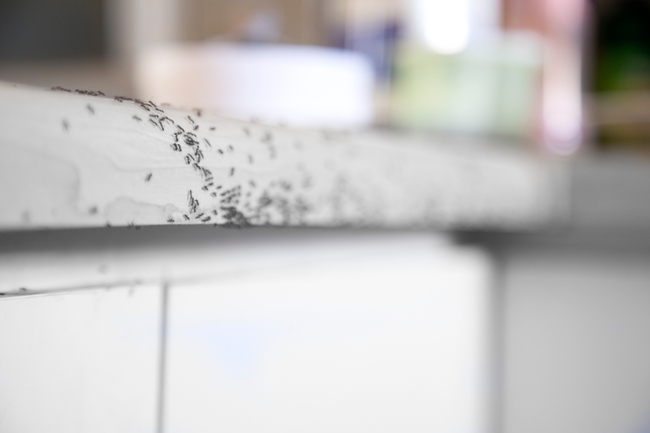Posts Tagged: ants
Controlling ants the healthy way
Spotting ants in the home or yard is no reason to reach for insecticide sprays or call an exterminator. UC Cooperative Extension experts say the insects can be managed by residents in ways that are effective, inexpensive, safe and environmentally kind.
“Ants are probably the No. 1 most common pests of our homes and gardens,” said Carolyn Kinnon, an environmental horticulturist and instructional associate at Mira Costa Community College. “Scientists find chemicals in our waterways that include pesticides commonly used to kill ants.”
Kinnon teamed up with UCCE community education specialist Scott Parker to present a Healthy Garden-Healthy Home online ant workshop during the COVID-19 pandemic to take the place of a planned in-person event. Healthy Garden-Healthy Home was initiated in 2005 with a grant from the California State Water Resources Control Board and continues with funding from San Diego County. With the move online, the workshop attracted four times more participants that usual.
“A silver lining of the COVID disaster has been our ability to reach out to many more individuals,” Parker said.
Healthy Gardens-Healthy Homes aims to cut residents' use of chemicals and reduce soil erosion that can wash into gutters with irrigation or rain water, course through storm drains and into streams, reservoirs and the Pacific Ocean. During the recent UCCE webinar on healthy ant control, Kinnon introduced science-based solutions that can be combined to keep ants at bay.
Use ant biology to battle ants
Ants are always looking for food and will forage any accessible source. Short circuiting this biological need is the first approach to controlling the pest. Outside, ants are often attracted to a sticky, sweet honeydew that pests like aphids leave behind when they feed on plants. Washing off aphids and honeydew with a sharp stream of water from the hose reduces the food source.
In spring, Kinnon said, ants like to feed on proteins, like seeds, nuts, dog food and other fatty substances. Fallen nuts, bird seed and leftover pet food should be discarded to reduce ant activity.
“When honeydew production from sap-sucking insects declines in the hot summer, and there is an absence of food sources outdoors, ants may come indoors,” she said. “Ants will travel several hundred feet in search for food.”
Removing inside food sources – like spills on counters and floors – and blocking access – by filling in holes and cracks – is the first defense against an indoor ant invasion. Kinnon recommends keeping food containers clean and sealed, rinsing empty recyclables – particularly sugar-sweetened beverages – and wiping up grease on barbecues and stove tops.
Wipe up ants and their chemical trails with an all-purpose cleaner, and fill tiny gaps, cracks and holes with caulk to make their entry difficult.
Managing expectations
Another way to achieve environmentally friendly ant management is coming to terms with the fact that they can't be eliminated from outdoor areas.
“Our goal is to focus on reducing population numbers,” Kinnon said. “We have to tolerate a certain number.”
Spraying a pesticide on an ant trail or sprinkling granular pesticides will only kill a fraction of the ants in the yard. Those materials can run off and pollute watersheds.
Baits
If cleaning up food sources, exclusionary measures and increased tolerance aren't enough, pesticide baits are an additional integrated pest management tool.
“This works because female worker ants take the bait back to the nest and feed it to other ants in the colony,” Kinnon said.
The bait must be slow acting so it doesn't kill the worker before she gets back to the colony. Kinnon recommended baits with no more than .5% active ingredient. For best bait placement, follow trails to find the nest and place the bait close by in a safe bait station. If the nest can't be found, the bait station can be placed along the trail.
Top 10 pests in gardens and landscapes and how to control them
Download the free booklet at the bottom of the page!
1. Ants

Most people deal with ants around their home at some point. Because most ants live outdoors, focus efforts on keeping ants from entering buildings by caulking entryways. Follow good sanitation practices to make your home less attractive to ants. Spraying ants inside the home will not prevent more ants from entering. Use baits to control the ant colony. Pesticide baits work by attracting worker ants who then take the poison back to the nest where the entire colony, including queens, can be killed. In the landscape, ants protect honeydew-producing pest insects from predators, so use sticky barriers or insecticide baits to keep ants out of trees and shrubs.
- Find out more at http://www.ipm.ucanr.edu/QT/antscard.html
2. Aphids

Aphids can curl leaves and produce sticky honeydew, but they rarely kill plants and you usually can wash them off with water. When aphid numbers get high, natural enemies such as lady beetles (lady bugs), lacewings, syrphid fly larvae, soldier beetles and others frequently feed on them, eliminating the need for pesticides. Protect these good bugs by avoiding the use of insecticides that can be toxic to a broad variety of insects. Ants protect aphids from these natural enemies, so keep ants away from your garden as well. When pesticides are necessary, use less toxic products such as insecticidal soaps and oils.
- Learn more about controlling aphids here: http://www.ipm.ucanr.edu/QT/aphidscard.html
3. Asian citrus psyllid and Huanglongbing disease

The Asian citrus psyllid (ACP) and the deadly bacterial disease it spreads, Huanglongbing (HLB), threaten citrus trees in backyards and on farms. There is no cure or effective control method for HLB disease. All types of citrus—including oranges, grapefruit, lemons, and mandarins—are affected as well as a few closely related ornamentals. ACP and HLB have already devastated the Florida citrus industry, and now that it is in the Western U.S. it is threatening the California citrus industry as well.
- See where the outbreaks are in California with our helpful Asian citrus psyllid website: http://ucanr.edu/sites/ACP/Distribution_of_ACP_in_California/
- Contact your agricultural commissioner's office, or call the California Department of Food and Agriculture (CDFA) Exotic Pest Hotline at 1-800-491-1899 to confirm a find. Learn more about ACP here: http://www.ipm.ucanr.edu/QT/asiancitruscard.html
4. Gophers

Gophers are small burrowing rodents that feed on roots of many types of plants. A single gopher can ruin a garden in a short time, and gopher gnawing can damage irrigation lines and sprinkler systems. In lawns, their mounds are unsightly and interfere with mowing. Early detection is critical to prevent damage. Use both traps and underground fencing to manage gopher problems. Toxic baits are available but can pose threats to wildlife, pets, and children, especially in backyard situations.
- Learn more about protecting your garden and landscape from gophers here: http://www.ipm.ucanr.edu/QT/gopherscard.html
5. Leaf-feeding caterpillars

Caterpillars, which are the larvae of butterflies and moths, damage plants by chewing on leaves, flowers, shoots, and fruit. Caterpillars in fruit or wood can be difficult to manage because they are hidden most of their life and can cause serious damage even when numbers are low. However, many plants, especially perennials, can tolerate substantial leaf damage, so a few leaf-feeding caterpillars often aren't a concern. Handpicking and beneficial predators and parasites often provide sufficient control. Look for feeding holes, excrement, webbed or rolled leaves, caterpillars, eggs, and good bugs.
- Learn more here:http://www.ipm.ucanr.edu/QT/lfcaterpillarscard.html
6. Peach leaf curl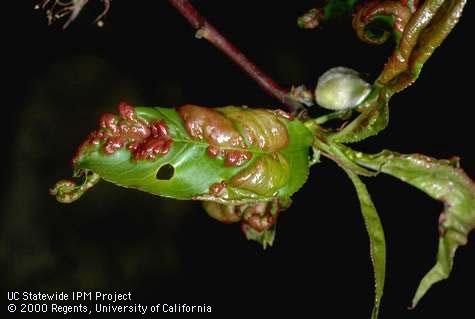

Peach leaf curl is a fungal disease that affects only peach and nectarine trees. Distorted, reddened foliage in the spring is a distinctive symptom. New leaves and shoots thicken and pucker and later may die and fall off. An infection that continues untreated for several years can lead to a tree's decline. To prevent peach leaf curl, treat peach and nectarine trees with a copper fungicide every year after leaves fall. After symptoms appear in the spring, any treatment will not be effective. When planting new trees, consider buying peach tree varieties that are resistant to the disease.
- To learn more about preventing peach leaf curl click here: http://www.ipm.ucanr.edu/QT/peachleafcurlcard.html
7. Rats

Rats eat and contaminate food, garden produce, and fruit, and transmit diseases to humans and pets. Manage rats by removing food and shelter, eliminating entryways into buildings, and trapping. Snap traps are the safest, most effective, and most economical way to trap rats. For Norway rats, place traps close to walls, behind objects, in dark corners, and in places where you have found rat droppings. For roof rats, place traps in off-the-ground locations such as ledges, shelves, branches, fences, pipes, or overhead beams. Ensure traps are out of reach of children and pets.
- Learn more about preventing and controlling rats here: http://www.ipm.ucanr.edu/QT/ratscard.html
8. Scales

Scale insects suck plant juices and are pests of many trees and shrubs. Infestations can cause yellowing or premature dropping of leaves, sticky honeydew, and blackish sooty mold. Plant parts can distort or die back, depending on the species and abundance of scales. Most plants tolerate low to moderate numbers of scales. Provide plants with proper cultural care, especially irrigation. Encourage scale predators such as lady beetles or lacewings and look for parasite emergence holes in scale covers. Use sticky barriers or insecticide baits to selectively control scale-tending ants. Consider replacing problem-prone plants because most scales are highly specific to certain plants.
- Learn more about controlling scale populations here: http://www.ipm.ucanr.edu/QT/scalescard.html
9. Snails and slugs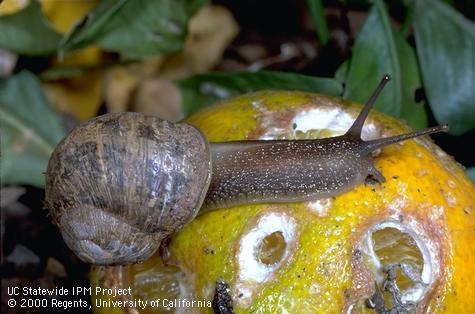

These slimy mollusks emerge from hiding at night and chew holes in leaves and flowers of many succulent garden plants and fruit. Management requires a vigilant and integrated approach that includes eliminating moisture and hiding spots, trapping, setting up barriers, and handpicking. Regularly remove snails from shelters you can't eliminate such as low ledges on fences, undersides of decks, and meter boxes. Place traps in your garden and dispose of trapped snails and slugs daily. Reduce moist surfaces by switching to drip irrigation or watering in the morning rather than later in the day. Consider snail-proof plants such as impatiens, geraniums, begonias, lantana, nasturtiums, and many plants with stiff leaves and highly scented foliage such as sage, rosemary, and lavender.
- Learn more about controlling snails and slugs with and without pesticides in your garden here: http://www.ipm.ucanr.edu/QT/snailsslugscard.html
10. Weeds in landscapes

Prevent weed invasions in new beds with good site preparation. Keep weeds out with an integrated program that includes competitive plants, mulches, and hand removal. Be particularly vigilant about removing aggressive perennial weeds. You rarely should need herbicides in established landscape plantings. Mulches prevent weed seed germination by blocking sunlight. Remove small weeds by hand before they flower and set seed. Use shallow cultivation or hoeing to remove annual weeds from ornamental plantings. Only use herbicides for special-problem situations before establishing new plantings or for difficult-to-control perennial weeds.
- Learn more about controlling weeds in your landscape here: http://www.ipm.ucanr.edu/QT/landscapeweedscard.html
To see all of the University of California's Statewide Integrated Pest Management Program's information on home, garden, and landscape pests, visit http://www.ipm.ucanr.edu/PMG/menu.homegarden.html
For other short pest “Quick Tips” like the ten above, see http://www.ipm.ucanr.edu/QT/
To read even more in-depth, peer-reviewed information on many other common home and landscape pests in California, see the Pest Notes series at http://www.ipm.ucanr.edu/PMG/PESTNOTES/index.html
Download your free UC IPM Quick Tips Booklet of the Top Ten Pests in Gardens and Landscapes and How to Control Them with the link below!
California drought may be causing shifts in pest invasion behavior
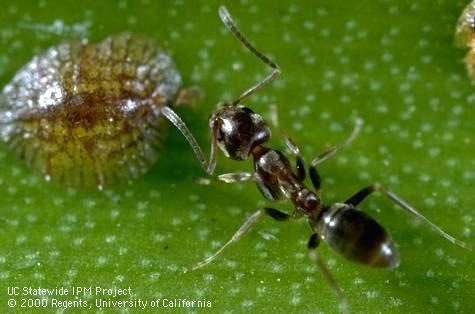
The drought may be driving more invasions by annoying insects such as ants, but not necessarily for the reasons one might expect.
Many people are asking, “Why are there so many more pests this year than usual?”
People may just be seeing more pests, according to an urban integrated pest management (IPM) advisor with UC Division of Agriculture and Natural Resources.
“The overall abundance of pests probably hasn't changed and may even have decreased as compared to wet years,” said Andrew Sutherland, Ph.D., urban IPM advisor for the San Francisco Bay Area. “The real questions we should be asking are ‘Why are these pests appearing earlier in the year?' and ‘Why are the pests appearing all at once as opposed to throughout the year?'”
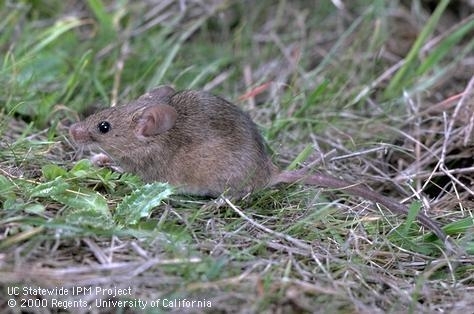
“This is also the first year we've seen dramatic changes made by residents due to mandated water-use restrictions,” Sutherland said. “Areas with frequent irrigation and lush landscapes aren't available this year so nuisance pests like outdoor cockroaches, ants and crickets are migrating from dry areas to seek moisture.”
This search may lead the thirsty pests to homes, garages or landscape that they haven't visited before. The IPM advisor used oriental cockroaches as an example.
“Oriental cockroaches are highly dependent on moisture and humidity and are not normally found indoors,” said Sutherland. “Outdoors, if you have an irrigation control box, leaky hosebib or water meter box, or a French drain system, that's where you'll find them. But if this water supply has been reduced or shut off, this population you didn't even know of – that may have existed for years – may crawl under doors or into foundation cracks and move indoors in search of water.”
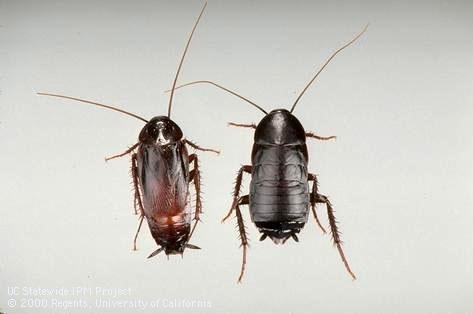
To learn more about home, garden, turf and landscape pests and how to exclude them, visit the UC Integrated Pest Management website at http://www.ipm.ucanr.edu/PMG/menu.house.html. For more advice on pest problems, contact the UC Master Gardeners at a local UC Cooperative Extension office http://ucanr.edu/County_Offices.
Further reading
Cockroaches http://www.ipm.ucanr.edu/PMG/PESTNOTES/pn7467.html?src=blog18995
Ants http://www.ipm.ucanr.edu/PMG/invertebrates/links.ants.html?src=blog18995
Rodents http://www.ipm.ucanr.edu/PMG/menu.house.html#VERT?src=blog18995
UC Master Gardeners http://mg.ucanr.edu/Become_a_Master_Gardener/Counties/?src=blog18995
Excluding seasonal nuisance pests http://www.ipm.ucanr.edu/PDF/PUBS/greenbulletin.2012.feb.pdf?src=blog18995
What do you know about ants?

If you think they're just uninvited guests at your picnic or something to spray or stomp, think again.
They're marvelous creatures, as any ant specialist will tell you.
You can learn about them from noted ant specialist Phil Ward, professor of entomology, UC Davis Department of Entomology and Nematology, when he presents a program Friday, July 17, on the native ants found in the Häagen-Dazs Honey Bee Haven, UC Davis campus.
The event, free and open to the public, is set from noon to 1:30 p.m. in the half-acre bee garden, located on Bee Biology Road, next to the Harry H. Laidlaw Jr. Honey Bee Research Facility, west of the central campus.
Among the native ants at the haven are:
- Dorymyrmex insanus (workers small, ~3 mm long, black; conspicuous crater-shaped nests in bare soil)
- Dorymyrmex bicolor (workers small, ~3 mm long, bicolored, dull orange and black; conspicuous crater-shaped nests in bare soil)
- Prenolepis imparis (also known as the “winter ant” or “winter honey ant”; workers small (3-4 mm long), brown, with shiny gaster; inconspicuous nests in soil)
- Formica moki (sometimes called “field ants”; workers medium-sized (6 mm long), with a dark head, orange-brown mesosoma (thorax) and silvery-gray gaster; nest in soil)
Images of these species can be found on the AntWeb, a website hosted and supported by the California Academy of Sciences that provides specimen-level data, images, and natural history of ants.
Approximately six other species of native ants reside in the vicinity of the garden, including Formica aerata, Pogonomyrmex subdentatus, and Solenopsis xyloni. The introduced Argentine ant (Linepithema humile) occurs around the Bee Biology building, but it appears not to have colonized the bee garden.
Attendees will learn how to observe and identify California native ants, and learn about the differences between bees and ants, said Christine Casey, director of the Häagen-Dazs Honey Bee Haven, which is owned and operated by the UC Davis Department of Entomology and Nematology. It was planted in the fall of 2009.
The program is part of a brown bag lunch series. For more information on the ant program, see the flier and/or access the haven web site.
Meanwhile, if you want to learn more about ants, be sure to download (free!) Dr. Eleanor's Book of Common Ants, an entry-level book by entomologist/science writer Eleanor Rice; entomologist/ant specialist/photographer Alex Wild (he received his doctorate in entomology from UC Davis, studying with Phil Ward, and is now a curator at the University of Texas, Austin); and designer Neil McCoy.
"Of the nearly 1,000 ant species living in North America, fewer than 30 are true pests, and fewer still actually can hurt us," Rice points out in her book. "We might not notice them, but they're there, and they shape, literally shape, our world," she writes. "Look at the colossal trees in your forest, the plants around your lawn. Ants, like winnow ants, plant the forest understory, ultimately contouring plant distribution that becomes those giants of trees, animal homes, abounding green life. Other ants help turn soil (more than earthworms in some places!), break up decomposing wood and animals, and keep the canopy healthy."
Ants are also crawling in the international spotlight now. Did you know the North American release of the superhero movie, Ant-Man, is Friday, July 17?
That makes Friday, July 17, a good day for ants.
Author: Kathy Keatley Garvey

Formica moki (Photo by Phil Ward, www.entweb.org)
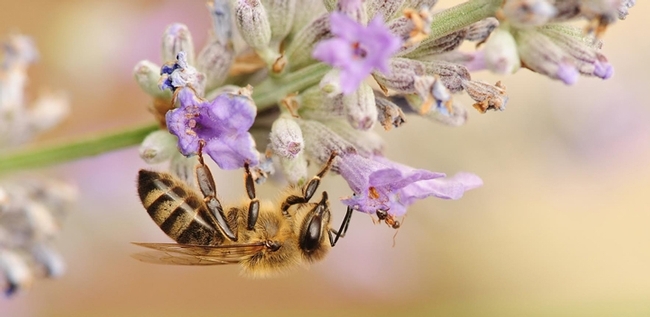
A honey bee and its cousin, an ant, a velvety tree ant, Liometopum occidentale. (Photo by Kathy Keatley Garvey)

An ant crater, the work of a species in the genus Dorymyrmex. (Photo by Kathy Keatley Garvey)
Calaveras board to vote today on multi-county partnership
The Calaveras County Board of Supervisors convenes at 9 a.m. Tuesday, Aug. 23, according to The (Calaveras County) Pine Tree. Among the items on the agenda is a proposal to adopt a minute order authorizing the chair to sign the inter-local agreement between the Regents of the University of California Cooperative Extension, Amador County, Calaveras County, El Dorado County and Tuolumne County for the provision of the UCCE program to the multi-county partnership.
Also in the news today:
In the weeds of bureaucratic insanity there sprouts a small reprieve
Steve Lopez, The Los Angeles Times
A Los Angeles man who took UC Cooperative Extension classes to learn gardening techniques has been asked to remove the plants he is growing in a city-owned parkway, the area between the curb and the sidewalk. UC Master Gardener Florence Nishida has helped the urban farmer by digging up the city's residential parkway landscaping guideline and advocating on the farmer's behalf.
Bait beats spray in war on ants
Vincent Lazaneo, Sign On San Diego
You may be tempted to grab a can of aerosol bug spray when you enter your kitchen in the morning and see ants on the counter, but UC Cooperative Extension home horticulture advisor Vince Lazaneo says there are a number of safer alternatives. Wipe up ants with soapy water, plug holes to outdoors, and use bait stations to control ant populations.
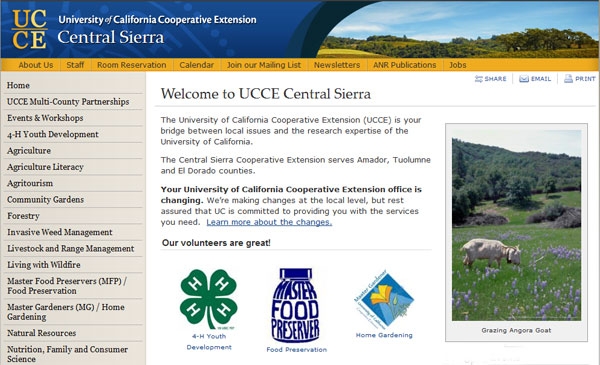
CentralSierrapage
